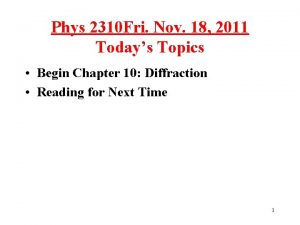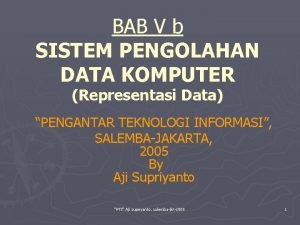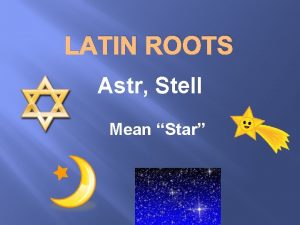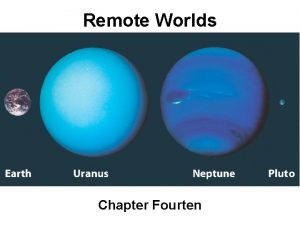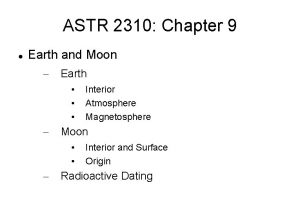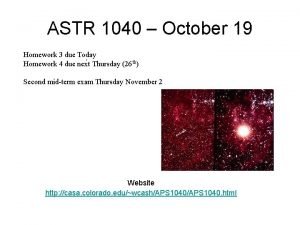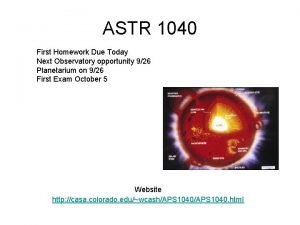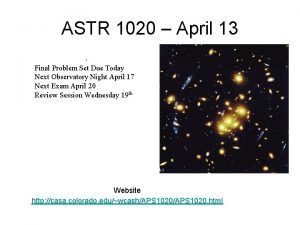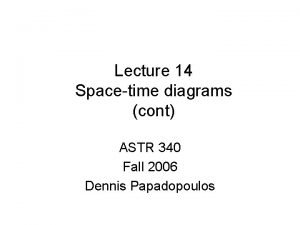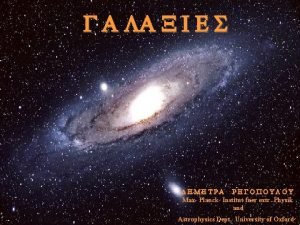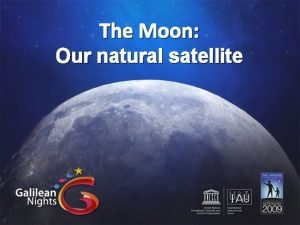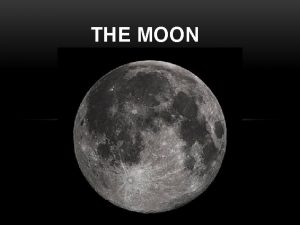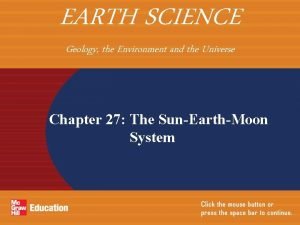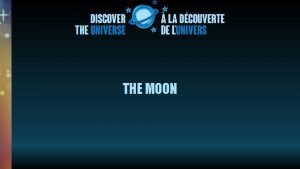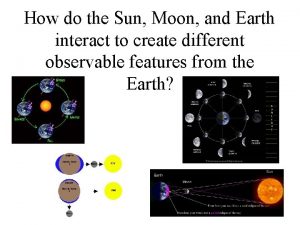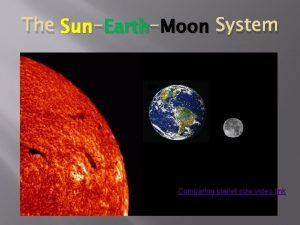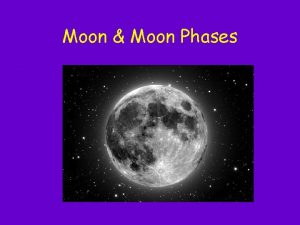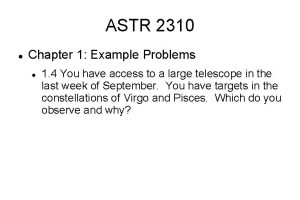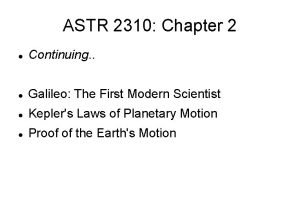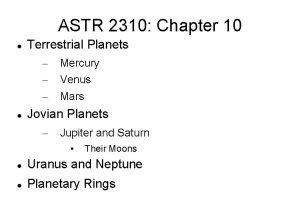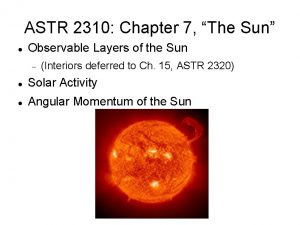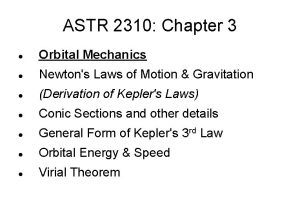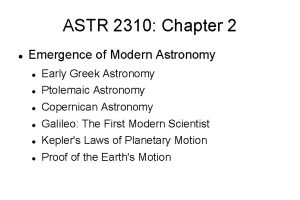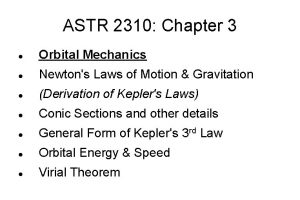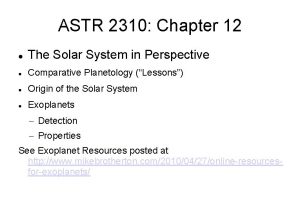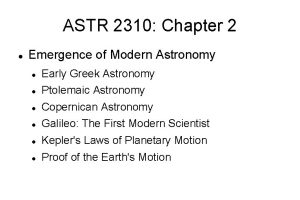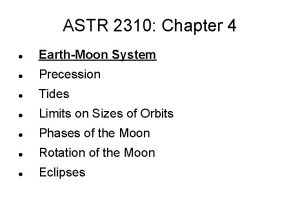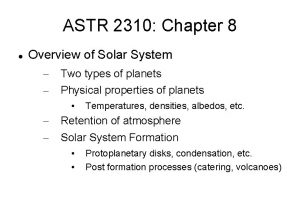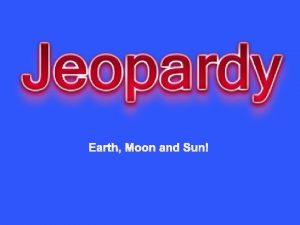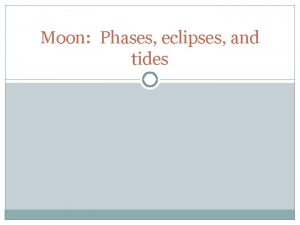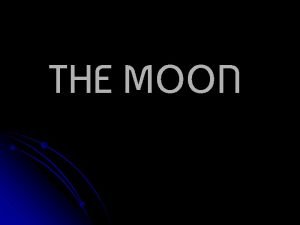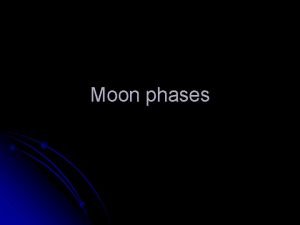ASTR 2310 Chapter 9 Earth and Moon Earth






















- Slides: 22

ASTR 2310: Chapter 9 Earth and Moon – Earth • • • – Moon • • – Interior Atmosphere Magnetosphere Interior and Surface Origin Radioactive Dating

ASTR 2310: Chapter 9 One of the most significant pictures EVER! Update: http: //www. youtube. com/watch? v=Tma. Oc. PYCGMA

ASTR 2310: Chapter 9 Earth's Interior – Differentiation:

ASTR 2310: Chapter 9 Earth's Interior – How do we know this stuff? Dammit Jim, I'm an astronomer not a geologist. . . – Like astronomy, there's a chain of indirect evidence that makes a consistent picture. . . – Seismic waves • • P-waves (pressure, or sound) S-waves (transverse waves, like in a rope)

ASTR 2310: Chapter 9 Earthquakes – – – Hypocenter vs. epicenter. . . Can triangulate to it P-Waves faster than S-Waves. . . • – Don't travel straight but bounce at interfaces where sound speed differs. Stiffer=faster, at higher densities, refracted upward Details (which I won't test over) let us map the interior of the Earth. Take geology for more!

ASTR 2310: Chapter 9 Details of the Earth's Structure – – Lithosphere (solid crust plus solid upper mantle) Asthenosphere (partially molten upper mantle) • • • – Plate tectonics (about a dozen plates) Rift zones (pulling apart) Subduction zones (going under – cue Evanescence) Core (about 5000 K, cooler than Sun's surface) • • • Radioactive materials (decay and heat) Geothermal heat – 2. 6 x 1013 W (double human consumption) Earth to remain geological active billions of yrs

ASTR 2310: Chapter 9 Earth's Atmosphere – – Not constant in time! Evolution here, too. . . – Outgassing by volcanoes brings up carbon dioxide and water (vapor). Solid carbonates made in oceans. – Finish up with non-reactive heavy gas like N 2. Initially volatile gas: H, He, methane, ammonia. . . As described, Earth can't hold H and He. . . Also, no ozone layer, so methane and ammonia broken down by UV light (photodissociation)

ASTR 2310: Chapter 9 Earth's Atmosphere – 3 billion years ago, life modifies the atmosphere – Photosynthesis creates O 2 as a byproduct – O 2 is very reactive, lots of consequences – Today, by number of molecules, DRY air: • • • Nitrogen is 78. 1% Oxygen is 20. 9% Argon is 0. 93% Carbon Dioxide is 0. 04% Other trace elements.

ASTR 2310: Chapter 9 Earth's Atmosphere – Hydrostatic Equilibrium and Scale Height – Balance pressure and gravity – Determines how thick an atmosphere is – Derivation on the board. . .

ASTR 2310: Chapter 9 Earth's Atmosphere

ASTR 2310: Chapter 9 Earth's Atmosphere: Hadley cells and winds

ASTR 2310: Chapter 9 Earth's Atmosphere: Effects on Astronomy – Rayleigh Scattering (particles smaller than the wavelength of the light you're studying). Effective cross section for scattering is inversely proportional to lambda to the 4 th power. Visible light is scattered by oxygen and nitrogen in the atmosphere as well as aerosols. This is why the sky is blue! Sunsets red! – Dust scattering, when the particle size is similar to the wavelength. Cross section is inversely proportional to wavelength. – Particle size larger than lambda. Water droplets. All wavelengths scattered. . . rainbows! – Also some dispersion – red and blue light refract slightly differently. Can be an important effect in slit spectra.

ASTR 2310: Chapter 9 Earth's Magnetosphere

ASTR 2310: Chapter 9 Earth's Magnetosphere: van Allen Belts

ASTR 2310: Chapter 9 Earth's Magnetosphere: ISS flying through an aurora at 28, 000 kilometers per hour

ASTR 2310: Chapter 9 Moon's Interior and Surface – Ave. Density is 3370 kg per cubic meter, similar to Earth's crust. No iron core here, although slightly differentiated. – Nearly “dead” geologically speaking – smaller and cools faster (same reason most animals can't be scaled up to giant versions) – Highlands and lowlands (mare or seas – not quite!). Mountains, craters, etc. – Radioactive dating indicates age is 4 Gyrs

ASTR 2310: Chapter 9 Moon's Interior and Surface – Cratering • Impact craters – – Escape velocity from sun at 1 AU is 42 km/s, and Earth orbits at 30 km/s, with moon around Earth of 1 km/s, so impacts can be up to 73 km/s. Deep penetration and vaporzation » Can be VERY energetic (depends on mass and speed, kinetic energy) Formation of crater and ejecta – explosions basically, and hence circular, ejecta can be glassy post melting Crater walls and central peak

ASTR 2310: Chapter 9 Moon's Interior and Surface – Cratering

ASTR 2310: Chapter 9 Moon's Interior and Surface – Differences between lunar and terrestrial rocks • • All lunar rocks are igneous – solidified lava (no sedimentary or metamorphic rocks) No water in lunar rocks (although new results suggest that moon retains some water) Iron in lunar rocks is not oxidized so no oxygen Depleted in volatile elements (exposed to heat in the past) – No large volcanoes on moon, but evidence of lava flows are seen (“rilles”) – Surface dust, aka “regolith”, some meters deep

ASTR 2310: Chapter 9 Origin of Moon – Our moon seems unusual compared to other terrestrial planets – Different hypotheses in the past: • • Fission Capture Co-creation And the winner is. . . – giant impact!

ASTR 2310: Chapter 9 Origin of Moon: http: //www. youtube. com/watch? v=m 8 P 5 uj. Nw. Ew. M

ASTR 2310: Chapter 9 Radioactive dating appendix – – Skipping formal lecture given lab activity Moving on. . .
 45(oktal) = … (desimal)
45(oktal) = … (desimal) 2310
2310 Konersi
Konersi Astr greek or latin
Astr greek or latin Trans neptunian objects
Trans neptunian objects Greek or latin root/affix deci words
Greek or latin root/affix deci words Astr
Astr Astr
Astr Astr
Astr Astr
Astr Inertial observers
Inertial observers That was due today
That was due today Astr ioi
Astr ioi Duo servicekantoor
Duo servicekantoor Which moon phase occurs directly before a new moon
Which moon phase occurs directly before a new moon Moon sister moon calendar
Moon sister moon calendar Home.hiwaay.net/ krcool/astro/moon/moon tides/
Home.hiwaay.net/ krcool/astro/moon/moon tides/ What phase is this
What phase is this Earth moon
Earth moon When the sun passes between the moon and earth
When the sun passes between the moon and earth How does the moon earth and sun work together
How does the moon earth and sun work together What season is this
What season is this Sun compared to earth
Sun compared to earth

